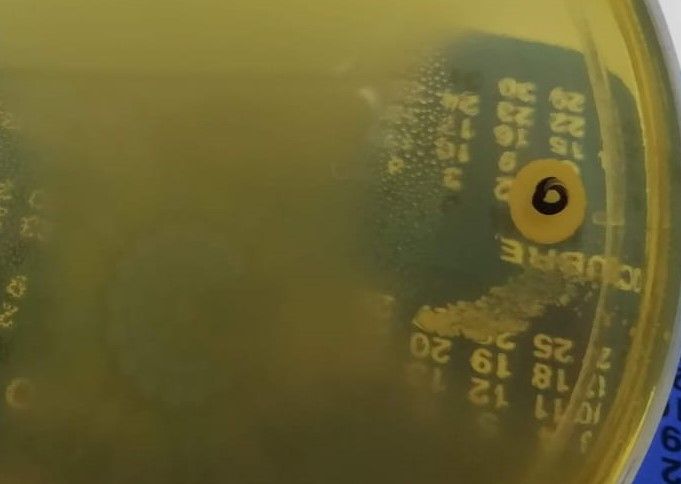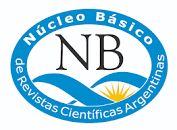Antimicrobial Sinergy Evaluation of Lactic Bacteria Strains Against Pathogens
DOI:
https://doi.org/10.19137/cienvet202325101Keywords:
Probiotics, Synergy, Lactobacillus, Antimicrobial ActivityAbstract
One of the most notable biological properties attributed to probiotics is their antimicrobial activity. Probiotics research has traditionally been focused on single strains, however, probiotic strains combinations can have a broader spectrum of action or synergistic effects, enhancing their protective action. The objective of this research was to evaluate the synergistic effect of lactic acid bacteria isolated from breast milk of different origins on the inhibition of bacterial pathogens of importance in human and animal medicine. Combinations of seven strains of lactic acid
bacteria paired together were used and their inhibitory effect on bacterial pathogens Escherichia coli ATCC 25922, Salmonella enterica ATCC 13076, Klebsiella pneumoniae ATCC 13883, Acinetobacter baumannii ATCC 19606 and an enterohemorragic E. coli strain was investigated. The combination TUCO-5E + TUCO-L2 was the most effective in inhibiting the growth of all pathogens evaluated, highlighting its effect on K. pneumoniae y A. baumannii. Five of the evaluated combinations showed synergistic effects in the inhibition of extraintestinal pathogens: a) a synergistic effect was observed between strains TUCO-5E + TUCO-L2 for the inhibition of K. pneumoniae and A. baumannii, b) synergistic effect for TUCO-5E + TUCO-2, TUCO-5 + TUCO-2, and TUCO-3 + TUCO-17 on K. pneumoniae and, c) synergistic effect for TUCO-16 + TUCO-17 on A. baumannii. The combinations that showed synergy in the antimicrobial effect are good candidates for the development of multistrain probiotics for the prevention and treatment of specific bacterial infections
Downloads
References
Ouwehand AC, Forssten S, Hibberd AA, Lyra A, Stahl B. Probiotic approach to prevent antibiotic resistance. Annals of Medicine. 2016; 48(4):246–255. Doi:10.3109/07853890.2016.1161232
Ghosh C, Sarkar P, Issa R, Haldar J. Alternatives to conventional antibiotics in the era of antimicrobial resistance. Trends Microbiol. 2019;
(4):323 – 327. Doi:10.1016/j.tim.2018.12.010
Food and Agriculture Organization & World Healt Organization (FAO / WHO). Probiotics in food: Health and nutricional properties and
guidelines for evaluation. FAO Food and Nutritional Paper 85 [Internet] 2006 [Consultado 15 Ago 2022] Disponible en: http://www.fao.org/3/a0512e/a0512e.pdf
Hill C, Guarner F, Reid G, Gibson GR, Merenstein DJ, Pot B, Morelli L, Canani RB, Flint HJ, Salminen S, Calder PC, Sanders ME. Expert consensus document: the international scientific association for probiotics and prebiotics consensus statement on the scope and appropriate use of the term probiotic. Nat Rev Gastroenterol Hepatol. 2014: 11:506-514. Doi:10.1038/nrgastro.2014.66
Reid G, Gadir AA, Dhir R. Probiotics: reiterating what they are and what they are not. Front Microbiol. 2019; 10:424. Doi:10.3389/fmicb.2019.00424
Binda S, Hill C, Johansen E, Obis D, Pot B, Sanders ME, et al. Criteria to qualify microorganisms as “Probiotic” in foods and dietary supplements. Front Microbiol. 2020; 11. Doi:10.3389/fmicb.2020.01662
Forssten SD, Laitila A, Maukonen J, Ouwehand AC. Probiotic triangle of success; strain production, clinical studies and product development. FEMS Microbiol Lett. 2020; 367(19). Doi:10.1093/femsle/fnaa167
Fontana L, Bermudez-Brito M, Plaza-Diaz J, Muñoz-Quezada S, Gil A. Sources, isolation, characterisation and evaluation of probiotics. B J Nutr. 2013; 109(S2): S35–S50. Doi:10.1017/S0007114512004011
Jugan MC, Rudinsky AJ, Parker VJ, Gilor C. Use of probiotics in small animal veterinary medicine. J Am Vet Med. 2017; 250(5): 519–528. Doi:10.2460/javma.250.5.519
King S, Tancredi D, Lenoir-Wijnkoop I, Gould K, Vann H, Connors G, et al. Does probiotic consumption reduce antibiotic utilization for common acute infections? A systematic review and meta-analysis. Eur J Public Health. 2019; 29(3): 494-499. Doi:10.1093/eurpub/cky185
Markowiak P, Slizewska K. Effects of probiotics, prebiotics, and synbiotics on human health. Nutrients. 2017; 9(9). Doi:10.3390/nu9091021
Mathipa MG, Thantsha MS. Probiotic engineering: towards development of robust probiotic strains with enhanced functional properties and for targeted control of enteric pathogens. Gut pathog. 2017; 9: 28. Doi:10.1186/s13099-017-0178-9
McFarland LV, Huang Y, Wang L, Malfertheiner P. Systematic review andmeta-analysis: multi-strain probiotics as adjunct therapy for Helicobacter pylori eradication and prevention of adverse events. United Eur Gastroenterol J. 2016; 4(4): 546–561. Doi: 10.1177/2050640615617358
Sornplang P, Piyadeatsoontorn S. Probiotic isolates from unconventional sources: a review. J Anim Sci Technol. 2016; 58(1). Doi:10.1186/s40781- 016-0108-2
Zielińska D, Kolożyn-Krajewska D. Food-origin lactic acid bacteria may exhibit probiotic properties: review. BioMed Res Int. 2018. Doi:10.1155/2018/5063185
Fernández L, Langa S, Martín V, Maldonado A, Jiménez E, Martín R, et al. The human milk microbiota: Origin and potential roles in health and disease. Pharmacol Res. 2013; 69(1): 1–10. Doi:10.1016/j.phrs.2012.09.001
Makete G, Aiyegoro OA, Thantsha MS. Isolation, identification and screening of potential probiotic bacteria in milk from South African Saanen goats. Probiotics Antimicrob Proteins. 2016; 9(3): 246–254. Doi:10.1007/s12602-016-9247-5
Reuben RC, Roy PC, Sarkar SL, Rubayet Ul Alam A, Jahid IK. Characterization and evaluation of lactic acid bacteria from indigenous raw milk for potential probiotic properties. J dairy sci. 2020; 103(2): 1223–1237. Doi: 10.3168/jds.2019-17092
Martín R, Delgado S, Maldonado A, Jiménez E, Olivares M, Fernández L, et al. Isolation of lactobacilli from sow milk and evaluation of their probiotic potential. J Dairy Res. 2009; 76: 418–425. Doi:10.1017/S0022029909990124
Quilodrán-Vega SR, Villena J, Valdebenito J, Salas MJ, Parra C, Ruiz A, et al. Isolation of lactic acid bacteria from swine milk and characterization of potential probiotic strains with antagonistic effects against swineassociated gastrointestinal pathogens. Can J Microbiol. 2016; 62(6): 514–524. Doi:10.1139/cjm-2015-0811
Martín R, Olivares M, Pérez M, Xaus J, Torre C, Fernández L, et al. Identification and evaluation of the probiotic potential of lactobacilli isolated from canine milk. Vet J. 2010; 185(2): 193–198. Doi:10.1016/j.tvjl.2009.04.014
Fernandez L, Martínez R, Cruz M, Arroyo R, Rodríguez JM. Characterization of Lactobacillus rhamnosus MP01 and Lactobacillus plantarum MP02 and assessment of their potential for the prevention of gastrointestinal infections in an experimental canine model. Front Microbiol. 2019; 10. Doi:10.3389/fmicb.2019.01117
Quilodrán-Vega S, Albarracin L, Mansilla M, Arce L, Zhou B, Islam MA, et al. Functional and genomic characterization of Ligilactobacillus salivarius TUCO-L2 isolated from Lama glama milk: a promising immunobiotic strain to combat infections. Front Microbiol. 2020; 11: 608752. Doi:10.3389/fmicb.2020.608752
Forssten SD, Ouwehand AC. Simulating colonic survival of probiotics in single-strain products compared to multi-strain products. Microb Ecol Health Dis. 2017; 28(1). Doi:10.1080/16512235.2017.1378061
Ouwehand AC, Invernici MM, Furlaneto FA, Messora MR. Effectiveness of multi-strain versus single-strain probiotics: current status and recommendations for the future. J Clin Gastroenterol. 2018; 52(S1): S35 – S40. doi:10.1097/mcg.0000000000001052
Timmerman HM, Koning CJ, Mulder L, Rombouts FM, Beynen AC. Monostrain, multistrain and multispecies probiotics - A comparison of functionality and efficacy. Int J Food Microbiol. 2004; 96(3): 219 - 233. Doi:10.1016/j.ijfoodmicro.2004.05.012
Chapman CM, Gibson GR, Rowland I. Health benefits of probiotics: are mixtures more effective than single strains? Eur J Nutr. 2011; 50(1): 1– 17. Doi:10.1007/s00394-010-0166-z
Gómez-Gallego C, Junnila J, Männikkö S, Hämeenoja P, Valtonen E, Salminen S, et al. A canine-specific probiotic product in treating acute or intermittent diarrhea in dogs: a double-blind placebo-controlled efficacy study. Vet Microbiol. 2016; 197: 122–128. Doi:10.1016/j.vetmic.2016.11.015
McFarland LV, Ship N, Auclair J, Millette M. Primary prevention of Clostridium difficile infections with a specific probiotic combining Lactobacillus acidophilus, L. casei, and L. rhamnosus strains: assessing the
evidence. J Hosp Infect. 2018; 99(4): 443 – 452. Doi:10.1016/j.jhin.2018.04.017
Collado MC, Meriluoto J, Salminen S. Development of new probiotics by strain combinations: is it possible to improve the adhesion to intestinal mucus?, J Dairy Sci. 2007; 90(6): 2710–2716. Doi:10.3168/jds.2006-456
Collado MC, Meriluoto J, Salminen S. In vitro analysis of probiotic strain combinations to inhibit pathogen adhesion to human intestinal mucus. Food Res Int. 2007; 40(5): 629 – 636. Doi:10.1016/j.foodres.2006.11.007
Collado MC, Grześkowiak Ł, Salminen S. Probiotic strains and their combination inhibit in vitro adhesion of pathogens to pig intestinal mucosa. Curr Microbiol. 2007; 55(3): 260 – 265. Doi:10.1007/s00284- 007-0144-8
Scalfaro C, Iacobino A, Nardis C, Franciosa G. Galleria mellonella as an in vivo model for assessing the protective activity of probiotics against gastrointestinal bacterial pathogens. FEMS Microbiol Lett. 2017; 364(7): 1 – 6. Doi:10.1093/femsle/fnx064, 46 - 42
Fijan S, Šulc D, Steyer A. Study of the in vitro antagonistic activity of various single-strain and multi-strain probiotics against Escherichia coli. Int J Environ Res Public Health. 2018; 15(7). doi:10.3390/ijerph15071539
Altarugio R, Vellano IH, Moraes AC, Milbradt EL, Andreatti-Filho RL, Guimarães-Okamoto PT, et al. In vitro probiotic selection and characterization of Lactobacillus spp. isolated from healthy domesticated Turkeys. J Appl Poult Res. 2017; 27(1): 81–91. doi:10.3382/japr/pfx045
Jimenez-Trigos E, Toquet M, Barba M, Gómez-Martín Á, Quereda JJ, Bataller E. Search of antimicrobial lactic acid bacteria from Salmonellanegative dogs. BMC Vet Res. 2022;18(1): 1 – 12. doi:10.1186/s12917- 021-03070-x
Chapman CM, Gibson GR., Rowland I. In vitro evaluation of single- and multi-strain probiotics: inter-species inhibition between probiotic strains, and inhibition of pathogens. Anaerobe. 2012; 18(4): 405 – 413.
Doi:10.1016/j.anaerobe.2012.05.004
Shokryazdan P, Sieo CC, Kalavathy R, Liang JB, Alitheen NB, Faseleh Jahromi M, et al. Probiotic potential of Lactobacillus strains with antimicrobial activity against some human pathogenic strains. BioMed Res Int. 2014; 927268. doi: 10.1155/2014/927268
Amstrong RA, Hilton AC. Statistical analysis in microbiology: Statnotes. USA: Wiley-Blackwell; 2011.
Lorowitz W, Saxton E, Sondossi M, Nakaoka K. Integrating statistics with a microbiology laboratory activity. Microbiology education. 2005; 6: 14– 19.
World Healt Organization (WHO). Global priority list of antibioticresistant bacteria to guide research, discovery, and development of new antibiotics. Geneva, Switzerland [Imternet] 2017 [Consultado 20 Mar
Disponible en: https://www.who.int/medicines/publications/WHO-PPLShort_ Summary_25Feb-ET_NM_WHO.pdf
Tejero-Sariñena S, Barlow J, Costabile A, Gibson GR, Rowland I. In vitro evaluation of the antimicrobial activity of a range of probiotics against pathogens: evidence for the effects of organic acids. Anaerobe. 2012; 18(5): 530-538. doi: 10.1016/j.anaerobe.2012.08.004
Chapman CM, Gibson GR, Todd S, Rowland I. Comparative in vitro inhibition of urinary tract pathogens by single- and multi-strain probiotics. Eur J Nutr. 2013; 52(6): 1669–1677. Doi:10.1007/s00394- 013-0501-2
Hwang SB, Chelliah R, Kang JE, Rubab M, Banan-MwineDaliri E, Elahi F, Oh DH. Role of recent therapeutic applications and the infection strategies of Shiga toxin-producing Escherichia coli. Front Cell Infect Microbiol. 2021; 11: 614963. Doi:10.3389/fcimb.2021.614963
Kim J-S, Lee M-S, Kim JH. Recent Updates on outbreaks of Shiga Toxin- Producing Escherichia coli and its potential reservoirs. Front Cell Infect Microbiol. 2020; 10:273. doi: 10.3389/fcimb.2020.00273, 56
Fernández J, Guerra B, Rodicio MR. Resistance to Carbapenems in Non- Typhoidal Salmonella enterica Serovars from Humans, Animals and Food. Vet Sci. 2018; 5(2): 40. doi:10.3390/vetsci5020040
Retamal P, Fresno M, Dougnac C, Gutierrez S, Gornall V, Vidal R, et al. Genetic and phenotypic evidence of the Salmonella enterica serotype Enteritidis human-animal interface in Chile. Front Microbiol. 2015; 6:464. doi: 10.3389/fmicb.2015.00464
Yang F, Deng B, Liao W, Wang P, Chen P, Wei J. High rate of multiresistant Klebsiella pneumoniae from human and animal origin. Infect Drug Resist. 2019; 12:2729-2737. doi: 10.2147/IDR.S219155.
Wang G, Zhao G, Chao X, Xie L, Wang H. The Characteristic of Virulence, Biofilm and Antibiotic Resistance of Klebsiella pneumoniae. Int J Environ Res Public Health. 2020; 17(17):6278. doi:10.3390/ijerph171762
Asif M, Alvi IA, Rehman SU. Insight into Acinetobacter baumannii: pathogenesis, global resistance, mechanisms of resistance, treatment options, and alternative modalities. Infect Drug Resist. 2018; 11: 1249– 1260. Doi: 10.2147/IDR.S166750
Van der Kolk JH, Endimiani A, Graubner C, Gerber V, Perreten V. Acinetobacter in Veterinary Medicine with emphasis on A. baumannii. J Glob Antimicrob Resist. 2019;16: 59 – 71.
Fijan S. Antimicrobial effect of probiotics against common pathogens. En: Rao V, Rao LG, editors. Probiotics and Prebiotics in Human Nutrition and Health. IntechOpen. 2016. p.191-211. Doi:10.5772/63141
Halder D, Mandal M, Chatterjee SS, Pal, NK, Mandal S. Indigenous probiotic Lactobacillus isolates presenting antibiotic like activity against human pathogenic bacteria. Biomedicines. 2017; 5(2). doi: 10.3390/biomedicines5020031

Downloads
Published
How to Cite
Issue
Section
License
Al momento de enviar sus contribuciones, los colaboradores deberán declarar , de manera fehaciente, que poseen el permiso del archivo o repositorio donde se obtuvieron los documentos que se anexan al trabajo, cualquiera sea su formato (manuscritos inéditos, imágenes, archivos audiovisuales, etc.), permiso que los autoriza a publicarlos y reproducirlos, liberando a la revista y sus editores de toda responsabilidad o reclamo de terceros , los autores deben adherir a la licencia Creative Commons denominada “Atribución - No Comercial CC BY-NC-SA”, mediante la cual el autor permite copiar, reproducir, distribuir, comunicar públicamente la obra y generar obras derivadas, siempre y cuando se cite y reconozca al autor original. No se permite, sin embargo, utilizar la obra con fines comerciales.







.jpg)

4.png)


7.png)



